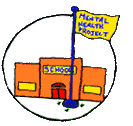


Last November, RAND published (with funding from the Gates Foundation) a
report entitled:
Continued Progress: Promising Evidence on
Personalized Learning, by John F. Pane, Elizabeth D. Steiner, Matthew D.
Baird, & Laura S. Hamilton – http://www.rand.org/content/dam/rand/pubs/research_reports/RR1300/RR1365/RAND_RR1365.pdf>
In January, William R. Penuel and Raymond Johnson provided a
review of the report for the Think Twice Think Tank Review Project at
the National Education Policy Center – http://nepc.colorado.edu/thinktank/review-personalized-learning.
They conclude that “readers should be skeptical of what promise the
report's evidence actually provides for any given model of personalized
learning being promoted or considered. The study does suggest that some
practices are associated with some test score gains, but those practices
may be quite different from those promoted under the flag of
personalized learning.”
We have long been concerned with the way
the construct of personalization in classrooms has morphed and been
co-opted, especially by those involved with bringing technology into the
classroom.
For example, the term "personalization" was emphasized
in the common core standards initiative, the proposed model core
teaching standards, the 2010 National Education Technology Plan, and
Race to the Top guidelines. In all these instances, the construct was
defined inadequately.
And, with respect to "innovative" school
practice, last year we noted concerns related to how the twenty New
England schools in the League of Innovative Schools were developing
"personalized learning experiences" to address the "distinct learning
needs, interests and aspirations of individual students." (See http://newenglandscc.org/connecticuts
graduation rate continues to rise/
All this, as well as the above report and review, are indications of
how policy makers have embraced the concept of personalized learning and
the various ways the term is interpreted. What the review of the report
underscores is that personalization is becoming a hot issue.
We think it is essential at this juncture to engage
folks in a broader discussion than is captured by those currently
advocating for personalization in the classroom.
Unfortunately,
discussions of personalized learning often do not distinguish
personalized learning from personalized instruction and usually fail to
place such learning and instruction within the context of other
conditions that must be improved in classrooms and school-wide to
address factors interfering with student learning and performance.
Our Center has focused on personalization for decades. Currently, it
is a major facet of our National Initiative for Transforming Student and
Learning Supports (https://smhp.psych.ucla.edu/newinitiative.html ).
We stress that personalized instruction, in contrast to
individualized instruction, strives to meet learners where they are -
not only with respect to current capabilities, but critically with
respect to motivational considerations. Moreover, even personalized
instruction is insufficient for addressing common barriers to learning
and teaching and re-engaging disconnected students. Such matters usually
also require providing special assistance for students and the
collaboration of teachers with student and learning support staff.
Learning is a nonlinear, dynamic, transactional, and spiraling process,
and so is teaching. And when it comes to addressing student learning,
behavior, and emotional problems, teachers can't do it alone.
We
hypothesize that properly conceived and implemented personalized
instruction and student and learning supports are essential to enabling
equity of opportunity, closing the achievement gap, assuring civil
rights, promoting whole child development, and fostering a positive
school climate.
We discuss all this in Adelman, H.S. & Taylor, L.
(2006). The Implementation Guide to Student Learning Supports: New
Directions for Addressing Barriers to Learning. Thousand Oaks, CA:
Corwin Press
and in two modules for continuing education:
>Module I provides some background, commonly used definitions, and
guidance for
personalizing learning.
https://smhp.psych.ucla.edu/pdfdocs/personalizeI.pdf
>Module II
highlights barriers to learning and teaching and classroom and
school-wide
strategies that build on personalization to address such
barriers and re-engage
disconnected students.
https://smhp.psych.ucla.edu/pdfdocs/persII.pdf
We also have a
Quick Find on the topic at https://smhp.psych.ucla.edu/qf/classenable.htm
,
and other related resources can be freely downloaded from our
Center website -- https://smhp.psych.ucla.edu/ .
WHAT’S YOUR TAKE
ON ALL THIS?
Send comments for sharing to Ltaylor@ucla.edu
*****************************
For a range of resources related to this matter,
see: National Initiative for Transforming Student and Learning Supports in 2016
| In addition, see the list of Emerging Issues identified over the years by the Center and used as a stimulus for discussion on our Net Exchange - https://smhp.psych.ucla.edu/newnetexchange.htm |
Previously highlighted hot issues
|
WebMaster: Perry Nelson (smhp@ucla.edu) |
 |